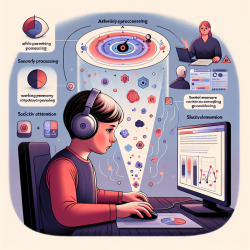As practitioners dedicated to fostering optimal outcomes for children, it's crucial to integrate data-driven insights into our therapeutic approaches. The recent study titled "The Relationship between Auditory Sensory Gating and Cognitive Functions on Auditory and Visual Modalities in Primary School Children" offers valuable findings that can enhance our practice.
This research explores how sensory gating—our brain's ability to filter out irrelevant stimuli—relates to cognitive functions like working memory and selective attention in both auditory and visual modalities. Here are some key takeaways from the study and practical ways to apply them in your practice:
Understanding Sensory Gating
Sensory gating involves the brain's capacity to suppress unnecessary stimuli, protecting it from information overload. The study assessed sensory gating using event-related potentials (ERPs) such as P50, N100, and P200 waves. Lower sensory gating ratios indicate better gating performance, meaning the brain is more effective at filtering out irrelevant stimuli.
Key Findings
- P50 sensory gating was negatively correlated with visual selective attention (P=0.034, r=-0.49).
- N100 sensory gating was negatively correlated with auditory working memory (P=0.043, r=-0.48) and visual selective attention (P=0.039, r=-0.47).
- P200 sensory gating showed a significant negative relationship with auditory selective attention in the right ear (P=0.034, r=-0.49).
Practical Applications
These findings suggest that sensory gating in one modality can influence cognitive functions in another, emphasizing the interconnectedness of sensory processing and cognitive abilities. Here are practical steps to integrate these insights into your therapeutic practice:
- Multisensory Integration: Incorporate activities that stimulate both auditory and visual modalities. For instance, use visual aids while engaging in auditory tasks to enhance selective attention and working memory.
- Targeted Interventions: Develop exercises that specifically aim to improve sensory gating. Activities that require children to focus on relevant stimuli while ignoring distractions can strengthen this ability.
- Continuous Monitoring: Regularly assess sensory gating and cognitive functions to tailor interventions effectively. Utilize tools like EEG to monitor progress and adjust strategies accordingly.
- Collaboration: Work closely with educators and parents to create a supportive environment that reinforces the skills developed during therapy sessions.
Encouraging Further Research
While this study provides valuable insights, there is still much to learn about the relationship between sensory gating and cognitive functions in children. Practitioners are encouraged to delve deeper into this area, conduct their own research, and share findings with the broader community.
To read the original research paper, please follow this link: The Relationship between Auditory Sensory Gating and Cognitive Functions on Auditory and Visual Modalities in Primary School Children.










